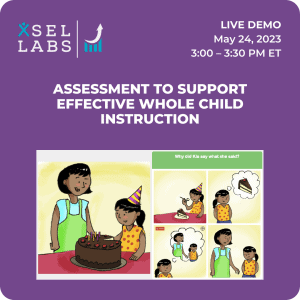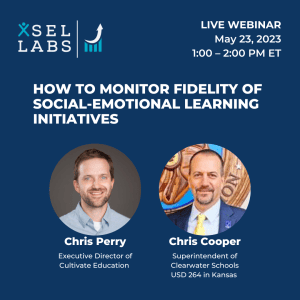Educators who want to focus on supporting student social and emotional learning (SEL) face very real challenges as they move from intention to action.
One of the more obvious challenges is how to go about teaching social and emotional skills. This blog post focuses on explicit instruction—the actions teachers can take designed to help students develop social and emotional skills.
There are two broad approaches to teaching social and emotional skills. One is to adopt and use a widely-available SEL program. Another is to adopt general practices that support student social and emotional development—sometimes called the “kernels” approach.
Let’s consider what each approach entails and their pros and cons.
Social and Emotional Learning Programs
SEL programs, such as those included in the Collaborative for Social and Emotional Learning, or CASEL, program guides, provide the resources required to provide structured instruction in SEL skills. Programs typically include lesson plans, materials, and a thoughtfully designed scope and sequence. Some include supplemental online materials. The modus operandi of programs is sequenced, active, focused, and explicit instruction. Districts who use programs typically purchase program materials and give them to their teachers, hopefully, along with professional development and guidance on the use of those programs.
The very best evidence suggests that when programs are implemented with sufficient intensity and quality, they produce academic, social, behavioral, and emotional benefits. SEL programs work. What’s not to like?
The problem with programs is that to do them right—with intensity and quality—is sometimes difficult to pull off. Barriers can come in the form of lack of skill or lack of will. Lack of skill refers to the professional competencies required to use an SEL scope and sequence with intensity and quality. Lack of will (somewhat obviously) refers to unwillingness to implement—often, this appears as some variation on the idea that there’s no time for yet another program.
Lack of skill is addressable through professional development; lack of will is addressable through leadership and sustained engagement. Still neither is an easy wall to climb.
Bottom line: Programs work if schools can pull them off. Note that done well, they also improve academic learning. But high-quality implementation is difficult.
Social and Emotional Instructional Practices
SEL practices, also called “kernels,” are bite-sized practices that teachers can use to support student social and emotional skill development. For example, to help students manage emotions, teachers can easily adopt the “turtle technique,” by which students learn a specific strategy to calm themselves when upset. Proponents of kernels argue that they are easy to adopt and include the active ingredients of SEL programs, but without the substantial barriers to implementation posed by programs.
The idea of simple and low-burden practices is incredibly appealing. The problem with kernels is that we don’t know if they work. Or maybe it’s more accurate to say that we don’t know what it takes to ensure that teachers learn to implement kernels with sufficient quality and intensity to benefit students.
Bottom line: Practices are feasible and compelling, but it’s not clear what it takes to make them effective.
The Best of Both Worlds
The programs proponents and the practices proponents each have important perspectives. The question for educators remains, how do I pull this off?
Well, let me reframe the problem a little, and dream a little, and then offer something a little more reality-based. The problem here is how to structure programs in a way that they can be adapted to local needs without completely losing their power to support student growth.
This problem has been solved. But not in the world of SEL.
A clinical child psychologist named John Weisz and his colleagues were up against a problem kind of like the programs and practices conundrum. They had developed and field-tested evidence-based psychotherapies for a range of child behavioral disorders. When implemented well, they produced demonstrable benefits. But it was really hard to get community mental health providers to use them.
Weisz and his colleague came up with a brilliant adaptation. They created a modular evidence-based therapy program. With it, community mental health providers assess their patients to determine the priority challenges and then use evidence-based modules—structured session plans—designed to address those specific challenges.
Turns out, therapists are more likely to use modular therapy approaches and they produce substantially greater improvement in child outcomes than standard approaches. Why? I suspect it’s because clinicians have the flexibility to adapt therapy approaches to suit the youth they are working with, and the approaches they select are highly effective.
What might the field of SEL take from this?
Here’s my take: Whoever cracks the nut of creating modular evidence-based SEL programs that can be flexibly adapted while maintaining the elements that make them powerful will make a giant impact on teaching and learning, and for the better.
Practical Strategies for SEL Programs and Practices
In the meantime, in my view, the best of both worlds consists of this: Select and use, with quality and intensity, an SEL program; and use the strategies contained in the lessons throughout the day to amplify the benefit of stand-alone lessons.
And like the modular therapy described earlier, good assessment can help you use your SEL program to build on student strengths and address student needs. See my earlier posts on Linking SEL Programs and Assessment and Strengthening SEL Program Implementation With Assessment Data.
Strong SEL assessment + a well-implemented program + regular use of practices, in my view, reflects the best way to use existing resources to support student SEL. It does not eliminate the challenges of implementation, but it gets us a step closer to using data to guide how we use program resources and everyday practice.
In SEL, as in all other matters, if it’s worth doing, it’s worth doing well.



